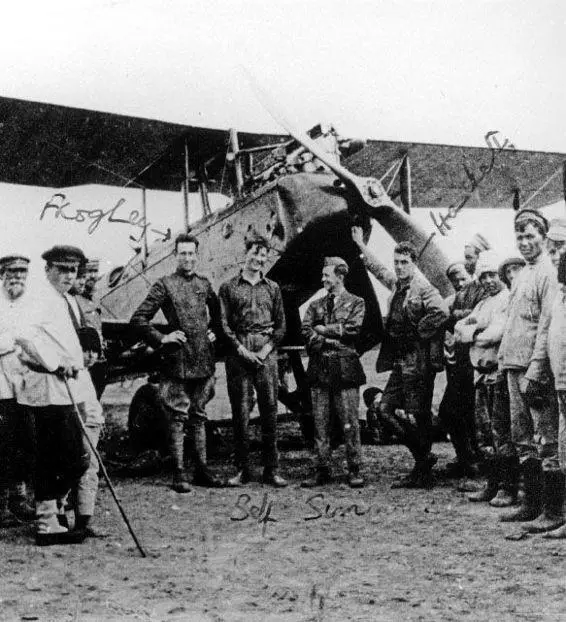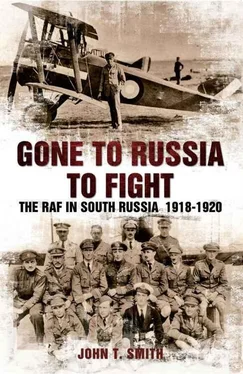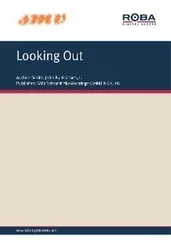The RAF squadrons in south Russia were never very large, but they played a role out of all proportion to their size. They were the only really effective air units available to the Russians. Number 47 Squadron, operating on the Tsaritsin front, played a significant part in Wrangel’s battles to hold onto the city. What the average members of the RAF thought they were doing in the middle of Russia is hard to judge. The British never really understood the situation in Russia or the issues involved. The average Russian was described as highly intelligent, cultured, and cosmopolitan, but also unreliable and utterly feckless. Much of the British aid vanished down a bottomless well of corruption, or was kept in storage at Novorossisk and never issued through inefficiency, only to fall into the hands of the Red Army.

Detail of picture here.
APPENDIX ONE
RAF PERSONNEL IN SOUTH RUSSIA
RAYMOND COLLISHAW
Although he is not as well remembered now as some other First World War pilots, Raymond Collishaw was one of the all-time great fighter pilots. He was born in Nanaimo, British Columbia, in 1893 and went to sea on leaving school. He served with the Canadian Fisheries Protection Service until he joined the Royal Naval Air Service in 1916. After learning to fly in England, he was posted to France to take part in the bombing campaign being mounted by the RNAS against Germany. While he was a member of 3 Wing, he flew a two-seat Sopwith 1½ Strutter on raids deep into Germany. During late 1916, he shot down two German fighters while flying Sopwith bombers. In February 1917, he was transferred to 3N Squadron, flying Sopwith Pup single-seat fighters. He shot down two German two-seaters before he was moved to 10N Squadron as a flight commander. This was a new squadron equipped with Sopwith Triplanes. Collishaw’s flight became the famous ‘Black Flight’, with the cowlings and wheels of all the aircraft painted black. Each of the aircraft was given a name, starting with ‘Black’; Collishaw’s was ‘Black Maria’. All the pilots in the flight became aces. By the time he left 10N Squadron, on 28 July 1917, Collishaw had shot down thirty-eight German aircraft. On 6 July 1917, he shot down six aircraft, the first pilot to claim six in one day.
The pictures of Collishaw show a slightly chubby, round, boyish face. But to belie this image, Collishaw became a complete killing machine. He returned to France in November as squadron leader of 13N Squadron, later 203 Squadron. Between then and September 1918, he raised his personal score to fifty-eight (possibly sixty-eight) German aircraft shot down. All the people who served with Collishaw who have written about the experience tell of a hard-living true leader of men. Ira Jones, who shot down forty German aircraft on the Western Front, served under Collishaw during the 1920s, and he later wrote of an occasion when Collishaw was a passenger in an aircraft that crashed in the desert:
When near Quizilrobat the engine concked and they crashed. Not depressed for a moment, Collishaw, who is the famous Canadian air ace, said to David [Hughie David, the pilot who crashed] as he disentangled himself from the passenger cockpit: ‘If we had some beer we could have a party.’ [1]
After the end of the First World War, Collishaw was offered a permanent commission in the RAF and, after a period of leave in Canada, he was sent to command 47 Squadron in south Russia.
Collishaw remained in the RAF, and during 1940-41 he commanded 201 Group in Egypt and, later, 12 Group of Fighter Command. He retired in 1943 as an air vice marshal. After returning to Canada, he worked in the mining industry before he died in 1976. Collishaw was one of the RAF’s great characters and fighting leaders.
Some of the claims that he made in his book Air Command about his time with 47 Squadron are hard to substantiate. Squadron records show that he carried out fewer combat sorties than he claimed. He stated that he flew seven combat sorties in one of B Flight’s Camels between 7 and 10 October 1919: during these seven flights he claimed to have had three combats with enemy aircraft and to have shot one of them down, on 9 October. In each case, the enemy aircraft was an Albatross D-V. No mention of this type of enemy aircraft appears anywhere else in the RAF records for Russia. Furthermore, Collishaw is not shown as ever flying one of B Flight’s aircraft and no mention of the shot-down aircraft can be found in squadron records. The idea that a squadron commander could shoot down an enemy aircraft and this not to be mentioned in the squadron records is not credible. In his log-book, Collishaw claimed that he was flying Camel B6396, though this aircraft was never listed as part of B Flight. In fact, records show that this aircraft was involved in a mid-air collision and was later broken up, on 12 November 1917, almost two years before Collishaw claimed he was flying it. Collishaw did not need to exaggerate: he was one of the great pilots.
SAMUEL MARCUS KINKEAD
Sam Kinkead was a South African, who was born in Johannesburg on 25 February 1897. He joined the RNAS in 1915. In 1916, he was with the Naval forces in the Dardanelles and was credited with shooting down three aircraft. He was later transferred to France, where he served in the 1st Naval Squadron and with 201 Squadron. By the end of the First World War, he had shot down thirty-two aircraft (possibly thirty-five). After he had returned from Russia, Kinkead again served with Collishaw in 30 Squadron. The squadron took part in several actions in support of Britain’s imperial policy in the Middle East. As one of the best pilots in the RAF, Kinkead was chosen to be part of the famous Schneider Trophy team. He crashed into the Solent on 12 March 1928 while flying a Supermarine S5, and was killed.
JOHN OLIVER ANDREWS
Andrews was a regular Army officer before the First World War. He transferred to the RFC and was an observer with 5 Squadron in France. By 1916, he had received pilot training and was serving with 24 Squadron in France. At the end of the war, he was a major commanding 209 Squadron. His final score was twelve aircraft destroyed and twelve aircraft driven down. After serving in Russia, he received a permanent commission in the RAF, finally retiring with the rank of air vice marshal.
ROWAN HEYWOOD DALEY
Daley was born on 30 March 1898. He joined the RNAS and by 1817 he had trained as a pilot and was serving with the Home Defence Forces. He later served in France with the 10th Naval Squadron, being wounded while flying a Camel. By the end of the war, he had shot down three German aircraft. After serving in Russia with 47 Squadron, he received a permanent commission in the RAF but was killed in a mid-air collision in 1923.
LEONARD HORATIO SLATTER
Born at Durban, South Africa, on 8 December 1894, he joined the RNAS at the start of the First World War and served with an armoured car unit. By 1915, he was an observer with a Short seaplane unit operating in France. He was selected for pilot training and by 1917 he was flying a Sopwith 1½ Strutter on bombing missions. Later in the war, he claimed seven enemy aircraft destroyed while flying Sopwith Pups and Camels. After serving in 47 Squadron in Russia, he went on to command various squadrons during the inter-war years. He also served on the aircraft carrier HMS Courageous . In 1937, he was promoted to group captain. This was followed by promotion to air commodore in 1940. He was AOC in Iraq and during the campaigns in Abyssinia and Eritrea. In late 1941, he was in command of 201 Group in Egypt. He was transferred back to Britain in 1943 to command 15 Group in Coastal Command. By 1945, he was the chief of Coastal Command, with the rank of air marshal. He died in 1961.
Читать дальше













